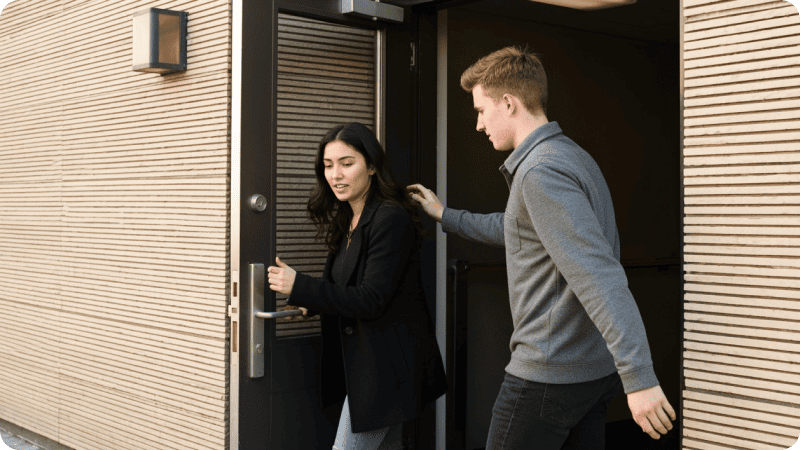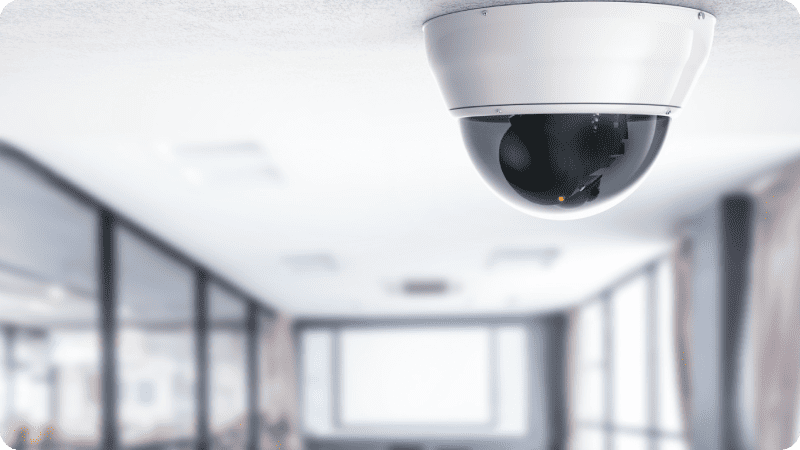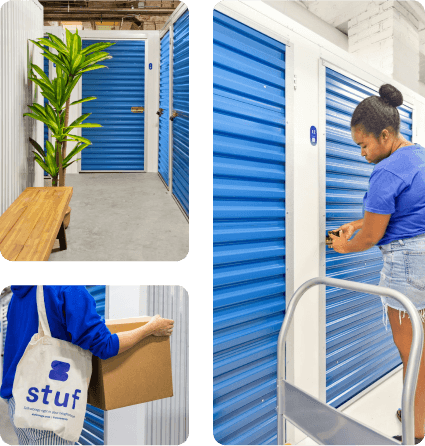When you lock the door on a self-storage unit, you should feel at ease, knowing your belongings are safe. Unfortunately, the harsh reality is that storage facilities are prime targets for theft.
Cargo theft data shows that 45% of reported cases in the third quarter of 2024 were from storage facilities. This represents a sharp increase from the 20% recorded in the same quarter of 2020. Additionally, according to a 2024 survey by Modern Storage Media,79% of storage facility operators report no drop in break-ins.
So, how secure is self storage, really?
In this guide, we’ll break down the risks most storage renters overlook, the security challenges facility owners face, and what you can do to make sure your belongings stay safe.
How Secure Is Self Storage in 2025?
The simple answer is that storage security depends on both the facility you choose and the precautions you take as a tenant.
While many modern facilities advertise advanced systems (surveillance cameras, coded gate access, and smart locks), not all facilities live up to their promises. Security can vary dramatically between operators, and even the best infrastructure can’t fully eliminate risk without smart tenant practices

Are Storage Units Safe: Challenges Storage Unit Owners Face?
Theft may be the most obvious concern for storage owners, but modern risks extend beyond a simple lock-and-key. Below, we break down the most common threats you may face when renting a storage unit.
-
Lock tampering and forced entry
Even with stronger lock technology available, thieves can still use simple tools like bolt cutters and drills to break into storage units. Criminals often look for the path of least resistance, targeting units with weaker or standard padlocks instead of high-security disc locks or cylinder locks. Once a lock is compromised, everything inside the unit is at risk. -
Tailgating and unauthorized access
Gated entry systems are only as strong as tenant behavior. If an unauthorized individual slips in behind a paying customer, a tactic known as “tailgating,” they can roam the facility freely without raising suspicion.Facilities without strict surveillance or access audits may never even know someone has unlawfully entered.
-
Insider risks
While rare, threats don’t always come from outside. Poor employee screening, shared access codes, or lax contractor oversig can lead to theft or misuse of access privileges.Without accountability measures like digital key logs or restricted permissions, tenants may be unknowingly exposed.
-
Vandalism and property damage
Storage units in poorly lit or unsupervised areas can become targets for graffiti, broken locks, or even arson. Beyond the financial impact, vandalism erodes tenant confidenceand signals to other criminals that the site may be under-protected. -
Cybersecurity breaches
The rise of “smart storage” adds convenience but also new risks.Online payment portals, mobile access apps, and smart locks can all be exploited by hackers. Even a basic phishing attack against an online payment system could expose tenant credentials, allowing criminals to bypass access systems altogether
Without strong cybersecurity measures such as encrypted locks, two-factor authentication, and regular system updates, your belongings could be at risk before anyone even touches the gate
-
Facility design flaws
Blind spots in camera systems, long hallways without visibility, or gates that don’t fully close create opportunities for theft. Criminals often scope out layouts in advance, looking for weak spots that make accessing units easier and less noticeable.

How to Evaluate Whether a Storage Facility Is Truly Safe
While many advertise themselves as “secure,” the reality is that safety depends on a combination of infrastructure, management practices, and tenant awareness. So, before signing a contract, evaluate a facility as carefully as you would a new home or office lease. Here’s how:
Questions to ask before renting
When touring or contacting a facility, don’t be shy about asking direct questions. A credible operator will be transparent, and the answers will reveal whether security is a priority or just a sales pitch.
Here are the questions to ask:
- Who oversees the property and how often?
Even if a facility isn’t staffed full-time, there should be property management, security patrols, or remote monitoring in place. - How are access points monitored?
Ask if entry logs are tracked and whether they record both vehicles and individuals. - What surveillance coverage exists?
Look beyond “we have cameras.” Ask about blind spots, recording quality (HD or outdated), and whether footage is monitored in real time. - How often is maintenance performed?
Broken gates, burned-out lights, or malfunctioning locks signal weak operational discipline. - What’s your incident history?
Reputable operators should be willing to discuss how often thefts or breaches occur and how they respond. - What happens if there’s a breach or emergency?
Look for clear escalation procedures, not vague answers. - Is the facility’s security integrated with the building it’s in?
Storage located inside commercial or residential complexes often benefits from multi-layered protection (controlled entry, cameras, on-site staff for the larger property).
These questions not only give you facts but also help you gauge how confident and knowledgeable the management team is about their own security.
Red flags to watch out for
Certain conditions should give you pause if your goal is to minimize theft and damage. This includes:
- Inconsistent monitoring –A total lack of surveillance or accountability is an issue. If staff can’t explain how the facility is watched after-hours, that’s a problem.
- Broken or poorly maintained gates/fences –If the perimeter looks neglected, it signals weak access control
- Dim lighting at night – Criminals thrive in places where there is insufficient lighting around entry points, driveways, and unit corridors
- Outdated or flimsy locks – If units still rely on traditional padlocks instead of disc locks or cylinder locks, they’re easier to cut or pick.
- No visible cameras or inactive surveillance – A lack of visible, working cameras means less deterrence and fewer ways to investigate incidents.
- Unmonitored access points – Too many unguarded entrances/exits make it easy for intruders to slip in unnoticed.
If you notice even one or two of these issues, it’s worth reconsidering whether the facility can actually keep your belongings safe.
Secure self storage: Visit checklist for renters
When looking for secure self storage, use this checklist to evaluate whether it offers real protection against theft and unauthorized access:
.png?width=622&height=1454&name=iPhone%2014%20Plus%20-%201%20(1).png)
Learn what other features to look for when looking for a reliable and secure storage facility to store your belongings in our guide.

What Can You Do to Improve Your Storage Safety
Even if you choose a secure storage facility, your own habits play a big role in protecting what you store. By taking a few extra steps, you can reduce risks and make sure your belongings stay safe.
-
Use strong locks
Invest in a high-quality disc lock or cylinder lock. These are harder to cut or tamperwith than standard padlocks. Some facilities even require them, but if not, it’s still worth the upgrade. -
Limit access
Only share your unit key or access code with people you completely trust. It may sound obvious, but many security breaches happen when codes or keys are passed around too casually -
Keep an inventory
Maintain a clear list (with photos) of what’s inside your unit. This helps you keep track of your items and provides proof for insurance purposes if something goes wrong.Not sure how to create an inventory for your storage? Check out our guide on creating a self-storage inventory to keep your unit organized.
-
Store valuables securely inside the unit
Don’t leave expensive items like electronics, jewelry, or sensitive documents loose. Place them in locked and labeled storage bins inside the unit. This creates a second layer of protection in case someone gains access. -
Add personal security measures
If allowed by the facility, consider extra security aids such as:- Padlocks with built-in alarms
- Security cables to secure large or valuable items
- Personal motion-detection cameras inside your unit
-
Visit regularly
One of the best ways to ensure storage safety is to stop by your unit from time to time. A quick visit lets you confirm everything is in order and spot any early warning signs of security issues.
Should You Insure Your Items in Secure Self Storage?
Even the most secure self storage facility can’t guarantee zero risk. Break-ins, natural disasters, or even a single security failure can lead to major losses.
That’s why insurance is a critical safety net. It steps in where locks, cameras, and gates fall short. Think of it as the final layer of protection in case security measures fail.
Do secure self storage facilities require insurance?
Some storage facilities make insurance mandatory, while others leave it up to tenants. However, even when it isn’t required, it’s still ideal to carry some form of coverage
The reasoning is simple: once items are outside your home, they’re no longer always covered by your standard homeowner’s or renter’s policy.
What does storage insurance typically cover?
Standard storage insurance usually protects against:
- Theft – if someone breaks into the facility or your unit.
- Fire damage – including smoke-related losses.
- Water damage – though coverage may exclude flooding or gradual leaks.
- Natural disasters – depending on the policy and location, but often limited.
Pro tip: Read the fine print carefully. Some categories of valuables (jewelry, cash, art, collectibles) may only be insured up to a low cap.
Does insurance cover theft or damage, or is that the renter’s responsibility?
Generally, theft or damage is covered if you have the proper insurance, but only up to the policy’s stated limit. Without insurance, the financial responsibility for loss rests on the renter, not the facility
Storage companies often make this clear in their contracts: they provide secure premises but don’t automatically guarantee reimbursement for damage or theft.
Alternatives and add-ons
If you’re already insured, your homeowners or renters insurance may extend limited protection to items stored offsite. However, these policies often cover only 10% of your personal property limit.
For renters needing broader coverage, facilities offer additional insurance options at signup. Stuf storage, for instance, offers an optional insurance add-on starting at $10/month. This policy protects up to $5000 of your belongings.
Protect Your Belongings with Smart Storage Choices
At the end of the day, protecting your belongings in storage comes down to three factors: choosing the right secure storage facility, taking responsibility for how you pack and secure your items, and ensuring you have the right insurance coverage in place. When all three work together, you can feel confident that your valuables are safe.
Stuf Storage facilities are designed with security as a top priority. From being located inside existing commercial and residential buildings, which adds a natural layer of controlled access, to advanced surveillance systems, smart locks, and optional insurance coverage, every detail is built to give you peace of mind.
Ready for storage that puts security first? Find a Stuf Storage location near you today and experience storage designed for the way you live and work.









